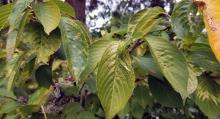See:
Cherry (Prunus spp.) - Cherry Mottle Leaf
Cherry (Prunus spp.) - Eola Rasp Leaf (Yellow Bud Mosaic)
Cherry (Prunus spp.) - Little Cherry
Cherry (Prunus spp.) - Necrotic Rusty Mottle (Lambert Mottle) and Rusty Mottle
Cherry (Prunus spp.) - Stem Pitting
Cherry (Prunus spp.) - Virus-induced Cherry Decline
Cherry (Prunus spp.) - X-Disease
Cherry Cultivar Susceptibility
Cause There are over 35 known virus and virus-like diseases of sweet cherry (Prunus avium), some with potential to cause severe economic impact. Infection by sweet cherry viruses can induce symptoms that stunt tree growth, affect the foliage (chlorosis, mottling, enations, rosetting) and fruit (deformed, dwarfed, lacking flavor) increasing susceptibility to other diseases, rapid tree decline, and mortality. Some viruses that do not cause severe disease on their own (such as PDV and PNRSV) and are found throughout the PNW. Other viruses pose the greatest threat to the sweet cherry industry, because they cause severe disease and are present in the PNW's most prominent commercial sweet cherry production regions. These viruses include cherry leaf roll virus (CLRV) causing Virus-induced Cherry Decline, cherry mottle leaf virus (CMLV), cherry necrotic rusty mottle virus (CNRMV), little cherry virus 1 and 2 (LChV1 & 2), tomato ringspot virus (ToRSV) causing Eola rasp leaf (Yellow Bud Mosaic) or stem pitting, and the bacterial (virus-like) pathogen Candidatus Phytoplasma pruni causing X-Disease. Combinations of different viruses infecting the same cherry tree can also be a major problem.
Reference Reinhold, L. A. and Pscheidt, J. W. 2023. Diagnostic and historical surveys of sweet cherry (Prunus avium) virus and virus-like diseases in Oregon. Plant Disease, 107:633-643.

